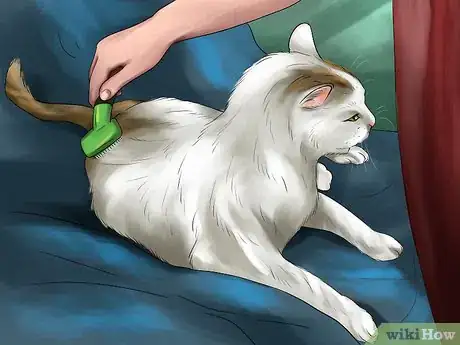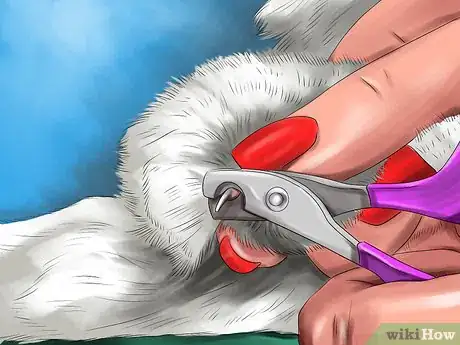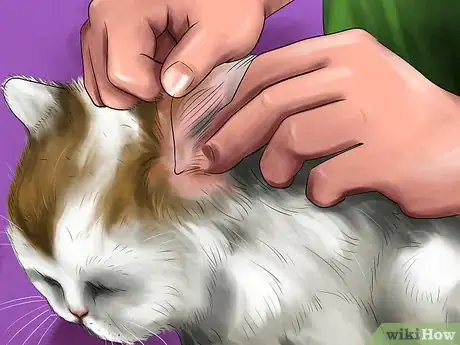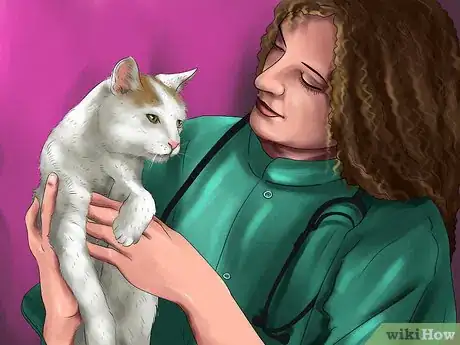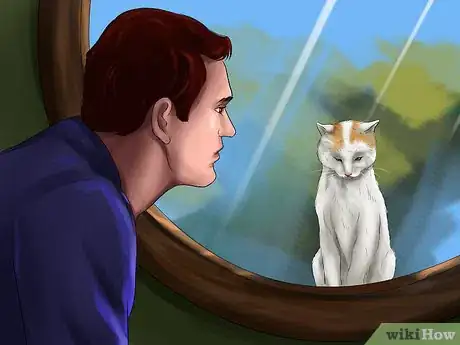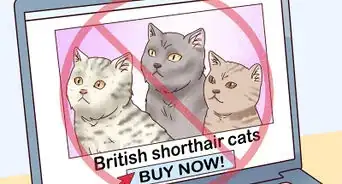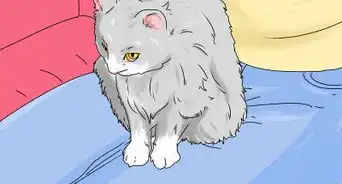This article was co-authored by Melissa Nelson, DVM, PhD. Dr. Nelson is a Veterinarian who specializes in Companion and Large Animal Medicine in Minnesota, where she has over 18 years of experience as a veterinarian in a rural clinic. She received her Doctor of Veterinary Medicine from the University of Minnesota in 1998.
There are 9 references cited in this article, which can be found at the bottom of the page.
This article has been viewed 25,038 times.
The Turkish Angora is an active and social cat who loves to be around their family. They are affectionate and gentle, but have a mischievous streak, especially if they think you are not paying enough attention to them. To care for your Turkish Angora, groom them often, look after their health, and provide plenty of activity and entertainment.
Steps
Grooming Your Turkish Angora
-
1Brush your cat every day. Turkish Angoras have beautiful, silky coats of a medium length. The coat does not have an undercoat, so it will not get tangled or matted. However, you should still brush the coat every day or every couple of days to keep it looking nice.[1]
- Use a long-toothed metal brush for your cat's longer coat. You can find these brushes at pet stores.[2]
-
2Trim your cat’s nails. You should trim your cat’s nails every few weeks to once a month. You can trim the nails yourself or you can take your cat to the vet to have them trimmed.[3]
- To trim the nails yourself, start by making your cat comfortable in your lap. Place your dominant hand around the cat’s upper body to secure them. Take one paw into your free hand. Gently press the paw so the claws come out. With your free hand, trim the nails.
- Make sure to avoid cutting the quick, which is the pink living part of the nail. Only trim the white part of the nail. If you are uncomfortable cutting the nails on your own, ask your groomer or vet tech to show you how to identify the quick and properly trim the nails.
Advertisement -
3Clean the ears. Make sure to clean your cat's ears once every couple weeks. This removes all dirt and buildup. Sometimes cats may clean their own ears, but not all of them will. Therefore, you should check your cat’s ears to see if they need cleaning. Use a damp cotton ball or cloth to clean the ears. Gently rub the inside of the ear flap with gauze or a cotton ball, avoiding the ear canal[4]
- Clean ears will be pink and odorless. Dirty ears are darker with visible dirt. They also may have a foul odor. If the ear has a foul odor or a lot of discharge, make an appointment with your vet, as this may be part of a larger medical problem.
-
4Brush your cat’s teeth. Cats can develop periodontal disease if their teeth aren’t taken care of. You can prevent gum disease by brushing their teeth often.[5] Make sure to brush their teeth with a cat toothpaste and a toothbrush with soft bristles. Never use human toothpaste on a cat. The fluoride is poisonous.
- You will probably have to get your cat used to the toothpaste. To do this, start by letting your cat taste the toothpaste. Place a small amount of it on your finger, and then let the cat lick it. After your cat gets used to the toothpaste, move your finger along the gums.
- After they are used to that, carefully rub a toothbrush that has toothpaste on it along the gums. Work on each tooth one at a time until the cat lets you brush all of the teeth.
Keeping Your Cat Healthy
-
1Feed your Turkish Angora a quality cat food. Because of the delicate bone structure of Turkish Angoras, you should make sure they do not get obese. To help with this, feed your cat a meat-based diet. Check the ingredient list on the label. Meat should be in the top two or three ingredients. Don’t give your cat foods that contain less than 40% protein.[6]
- To monitor your Turkish Angora’s weight, weigh them once a month. If your cat starts gaining a few pounds, cut back on their food.
- Look for the AAFCO certification on the cat food to ensure it is quality. You can also talk to the vet for high-quality cat food suggestions.
-
2Take your cat to the vet. Turkish Angoras are usually healthy cats, but they can develop heart and hearing problems. To make sure they stay healthy, take your cat to get the vet regularly. You should take them at least once each year.
- Get your cat all their vaccinations and their boosters each year. Your cat should receive FPV, Rabies, FeLV, FIV, FIP, Chlamydophila felis, Bordetella, and Feline Giardia vaccine courses soon after adoption. They will also need an annual rabies booster.[7]
-
3Spay or neuter your cat. If you are not planning on breeding your cat, have them spayed or neutered as soon as possible. You can desex your cat at around five to six months of age. Spaying or neutering can help reduce negative behaviors, like spray marking, and help also reduce the risk of mammary tumors and uterine infection common in unspayed female cats.
-
4Notice any hearing problems. Turkish Angoras that have blue eyes may develop hearing problems. If your cat is white with two blue eyes, they may develop complete deafness in both ears. If your Turkish Angora has only one blue eye, they will probably only use hearing in one ear.[8]
-
5Monitor for heart problems. Turkish Angoras are genetically predisposed to have hypertrophic cardiomyopathy. This is a common type of heart disease that cats get where the muscle thickens. Take your cat to the vet to get them screened for HCM.[9]
- Reputable breeders won’t breed Turkish Angoras that have HCM. However, never trust a breeder who promises you an HCM-free cat or that the cat came from a HCM-free line.
Creating a Nurturing Environment
-
1Provide plenty of places to climb. Turkish Angoras love to climb, jump, and play. They will climb on bookcases and tall cabinets. Because of this, you should give your cat plenty of vertical space. Consider placing cat trees, cat shelves, and other vertical furniture in your house.[10]
- You may want to place perches up high for your Turkish Angora to lay and watch what’s going on. Cat shelves that lead to a shelf over a door or near a window for watching and napping will be ideal.
-
2Interact with your cat often. Turkish Angoras are very social. They like to be around their human family, right in the middle of whatever activity you are doing. Make sure to take time each day to spend with your cat. This breed does not do well if they spend too much time alone. They will get into trouble just to get your attention. This is not an aloof cat.[11]
- This cat does well with all types of family members, including children and seniors.
- Turkish Angoras are not known to be lap cats, and most only like to be held in limited amounts. However, they love to be near you in the same room.
-
3Give your cat plenty of toys. Turkish Angoras are active cats that love toys. Make sure your cat gets enough physical activity to keep them occupied and prevent them from getting bored and engaging in negative behaviors. Giving them toys can help with this.[12]
- This breed loves to run after and pounce on toys. Consider giving your cat toys to play with, like fake mice or dangling toys. You can also play with your Turkish Angora by tossing a soft ball or piece of paper for them to chase, or having them chase a laser pointer.
- Provide your cat a scratching post to help keep them active.
-
4Provide a companion for your cat. Turkish Angoras are social cats. They like to interact with others, whether that is a human family member or another pet. Consider getting another pet for your Turkish Angora if you don’t have one. This will help keep them active, occupied, and out of trouble.
- You may get another cat or a cat-friendly dog.
References
- ↑ http://www.hillspet.com/en/us/cat-breeds/turkish-angora
- ↑ https://vcahospitals.com/know-your-pet/grooming-and-coat-care-for-your-cat
- ↑ http://cattime.com/cat-breeds/turkish-angora-cats#/slide/1
- ↑ https://www.aspca.org/pet-care/cat-care/ear-care
- ↑ http://cattime.com/cat-breeds/turkish-angora-cats#/slide/1
- ↑ http://www.hillspet.com/en/us/cat-breeds/turkish-angora
- ↑ http://www.catvets.com/public/PDFs/PracticeGuidelines/VaccinationGLS-summary.pdf
- ↑ http://cattime.com/cat-breeds/turkish-angora-cats#/slide/1
- ↑ http://www.vetstreet.com/cats/turkish-angora#health
About This Article
To take care of a Turkish Angora, brush it every day to keep its silky, medium-length coat looking nice. Because of its delicate bone structure, make sure your cat maintains a healthy weight by feeding it a meat-based commercial cat food. In addition to a healthy diet, you'll also want to give your cat plenty of places to climb, jump, and play. You can also give your cat fake mice or soft balls to pounce on and chase. Since Angoras are social, make sure to spend time with your cat every day, whether cuddling or dangling cat toys over its head. Though generally healthy, Turkish Angoras can develop heart and hearing problems, so make sure to take your cat to its yearly veterinary exam. For more tips from our Veterinary co-author, including how to provide your cat with a companion pet, keep reading!
